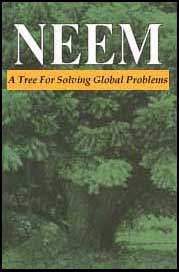
Neem A Tree for Solving Global Problems (BOSTID, 1992, 127 p.)
The BOSTID Innovation Program
Since its inception in 1970, BOSTID has had a small project to evaluate innovations that could help the Third World. Formerly known as the Advisory Committee on Technology Innovation (ACTI), this program has been identifying unconventional developments in science and technology that might help solve specific developing country problems. In a sense, it acts as an "innovation scout" - providing information on options that should be tested or incorporated into activities in Africa, Asia, and Latin America.
So far, the BOSTID innovation program has published about 40 reports, covering, among other things underexploited crops, trees, and animal resources, as well as energy production and use. Each book is produced by a committee of scientists and technologists (including both skeptics and proponents), with scores (often hundreds) of researchers contributing their knowledge and recommendations through correspondence and meetings.
These reports are aimed at providing reliable and balanced information, much of it not readily available elsewhere and some of it never before recorded. In its two decades of existence, this program has distributed approximately 350,000 copies of its reports. Among other things, it has introduced to the world grossly neglected plant species such as jojoba, guayule, leucaena, mangium, amaranth, and the winged bean.
BOSTID's innovation books, although often quite detailed, are designed to be easy to read and understand. They are produced in an attractive, eye-catching format, their text and language carefully crafted to reach a readership that is uninitiated in the given field. In addition, most are illustrated in a way that helps readers deduce their message from the pictures and captions, and most have brief, carefully selected bibliographies, as well as lists of research contacts that lead readers to further information.
By and large, these books aim to catalyze actions within the Third World, but they usually also have utility in the United States, Europe, Japan, and other industrialized nations.
So far, the BOSTID innovation project on underexploited ThirdWorld resources (Noel Vietmeyer, Director and Scientific Editor) has produced the following reports.
Ferrocement: Applications in Developing Countries (1973). 89 pp.
Mosquito Control: Perspectives for Developing Countries (1973). 62 pp.
Some Prospects for Aquatic Weed Management in Guyana (1974). 33 pp.
Roofing in Developing Countries: Research for New Technologies (1974). 70 pp.
An International Centre for Manatee Research (1974). 34 pp.
More Water for Arid Lands (1974). 149 pp.
Products from Jojoba (1975). 30 pp.
Underexploited Tropical Plants (1975). 184 pp.
The Winged Bean (1975). 39 pp.
Natural Products for Sri Lanka's Future (1975). 53 pp.
Making Aquatic Weeds Useful (1976). 169 pp.
Guayule: An Alternative Source of Natural Rubber (1976). 77 pp.
Aquatic Weed Management: Some Prospects for the Sudan (1976). 57 pp.
Ferrocement: A Versatile Construction Material (1976). 106 pp.
More Water for Arid Lands (French edition, 1977). 148 pp.
Leucaena: Promising Forage and Tree Crop for the Tropics (1977). 110pp.
Natural Products for Trinidad and the Caribbean (1979). 50 pp.
Tropical Legumes (1979). 326 pp.
Firewood Crops: Shrub and Tree Species for Energy Production (1980). 236 pp.
Water Buffalo: New Prospects for an Underutilized Animal (1981). 111 pp.
Sowing Forests from the Air (1981). 56 pp.
Producer Gas: Another Fuel for Motor Transport (1983). 95 pp.
Producer Gas Bibliography (1983). 50 pp.
The Winged Bean: A High-Protein Crop for the Humid Tropics (1981). 41 pp.
Mangium and Other Fast-Growing Acacias (1983). 56 pp.
Calliandra: A Versatile Tree for the Humid Tropics (1983). 45 pp.
Butterfly Farming in Papua New Guinea (1983). 33 pp.
Crocodiles as a Resource for the Tropics (1983). 52 pp.
Little-Known Asian Animals With Promising Economic Future (1983). 125 pp.
Casuarinas: Nitrogen-Fixing Trees for Adverse Sites (1983). 112 pp.
Amaranth: Modern Prospects for an Ancient Crop (1983). 74 pp.
Leucaena: Promising Forage and Tree Crop (Second edition, 1984).93 pp.
Jojoba: A New Crop for Arid Lands (1985). 100 pp.
Quality-Protein Maize (1988). 100 pp.
Triticale: A Promising Addition to the World's Cereal Grains (1989). 103 pp.
Lost Crops of the Incas: Little-Known Plants of the Andes with Promise for Worldwide Cultivation (1989). 415 pp.
Microlivestock: Little-Known Small Animals with a Promising Economic Future (1991). 450 pp.
Neem: A Tree For Solving Global Problems (1992). Vetiver Grass (1993). 141 pp.
Lost Crops of Africa: Volume 1 - Grains (1994).
Lost Crops of Africa: Volume 2 - Cultivated Fruits
Lost Crops of Africa: Volume 3 - Wild Fruits
Lost Crops of Africa: Volume 4 - Vegetables
Lost Crops of Africa: Volume 5 - Legumes
Lost Crops of Africa: Volume Roots and Tubers
Underexploited Tropical Fruits